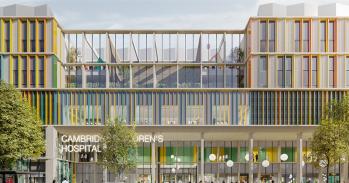
Per capita access to hospitals, mental health services, and further education facilities in German towns and cities – primarily in the former GDR – now outstrip equivalent areas in England, often several times over, according to research.
Per capita access to hospitals, mental health services, and further education facilities in German towns and cities – primarily in the former GDR – now outstrip equivalent areas in England, often several times over, according to research.
Even England’s wealthier areas are falling short of equivalent places in Germany
Diane Coyle
A new report outlines the dismal state of England’s physical and 'social' infrastructure – from public services in health and education to the parks, cinemas and train stations that prop up communities – when compared to similar regions in what was once East Germany.
The report’s authors call for a “universal basic infrastructure” (UBI) if the UK is to ‘level up’ its regions and lift itself out of 'flatlining' productivity rates. This UBI would see a minimum level of public and private sector services covering everything from broadband to bus routes.
Researchers matched eleven parts of England such as Manchester and Peterborough with German areas close in population and productivity, primarily in the former Soviet bloc – as this region was a central case study in the UK government’s flagship 2022 ‘Levelling up’ White Paper.
The report, led by the Bennett Institute for Public Policy at the University of Cambridge, found that in 2021, German towns, cities and regions have on average twice as many hospitals and pharmacies per 100,000 people as their English counterparts.
Places in Germany have over 11 times more mental health centres and practitioners, and eight times more further education providers, than equivalent parts of England, according to 2021 data.*
In 2020, German areas also have twice as many railway stations per 100,000 people as matching English areas, although England averages almost four times more bus stops than Germany.
“Access to physical and social infrastructure across England is highly variable, and shortfalls in provision affect both declining and growing areas,” said report co-author Professor Diane Coyle from Cambridge University’s Bennett Institute for Public Policy.
“But even England’s wealthier areas are falling short of equivalent places in Germany, and have seen notable declines in a wide range of types of infrastructure over much of the last decade.”
The report shows that areas such as Cambridge and Manchester have more healthcare facilities per 100,000 people, for example – as well as more banks, museums and restaurants – compared to areas such as Bolton, Rochdale and Stevenage.
In fact, Cambridge, one of the country’s wealthiest locations outside of London, has over twice as many banks and building societies, on average, and over six times as many further education providers, as Oldham, Central Bedfordshire and Rochdale.
However, the team also found that many elements of “social infrastructure” right across all eleven English areas have tumbled since 2014, regardless of regional wealth and average rates of income.
The availability of public transport, GP practices, hospitals, mental health care, police stations, banks, cash machines, post offices, primary and further education facilities, theatres, swimming pools, museums, shopping centres, and chemists have declined across almost all English areas analysed in the report.
All local authorities analysed in the report reduced at least one type of health service between 2014 and 2023. For example, Blackpool, Central Bedfordshire, Stevenage and Stoke-on-Trent all decreased their number of clinics, GP practices, hospitals, and dental treatment centres.
Even in Cambridge the number of further education facilities per 100,000 people halved between 2014 and 2023, and GP practices per capita fell by over 14%.
The number of police stations per capita fell in all places except Bolton, and the number of public parks and gardens reduced in four out of the five areas with data. Contrary to public perception, however, the number of libraries increased across most authorities in the report.
“Universality across the nation is key when it comes to the infrastructure that facilitates most aspects of our daily lives,” said report co-author Stella Erker from Cambridge University’s Bennett Institute for Public Policy.
“The community assets we should all have access to, not just schools and doctors but parks, trains, pubs and gyms, are the foundation for human wellbeing, which in turn underpins economic growth.”
The researchers point out that even rapidly expanding places in England are seeing social infrastructure go in the opposite direction – an impediment to desperately needed house-building.
For example, Bedford sits in the ‘Ox-Cam-Arc’ – an economic boom region encompassing Oxford, Cambridge and London – and is growing at three times the national rate, expanding by nearly 18% between 2011 and 2021.
Yet the town has seen local services weaken, with reductions per capita in everything from bus stops and rail facilities to GP capacity, primary schools, and local banks and cashpoints, since 2014.
The report calls for “provision presumptions”: thresholds at which existing services cannot be reduced. Coyle, Erker and their co-author Prof Andy Westwood from the University of Manchester argue that a minimum UBI level should be tied to an area’s population growth.
Added Westwood: “Achieving a minimum level of universal basic infrastructure is an ambitious but necessary goal if we want to create economic opportunity across the country. It would prevent the current ‘postcode lottery’, and serve as a catalyst for growth in ‘left behind’ areas, as well as places that are growing rapidly but too often without adequate infrastructure and services.”
Full list of towns, cities and areas analysed in report as follows:
England: Bedford, Blackpool, Bolton, Cambridge, Central Bedfordshire, Manchester, Oldham, Peterborough, Rochdale, Stevenage, Stoke-on-Trent.
East Germany: Bautzen, Cottbus, Erfurt, Halle an der Saale and Rostock. The report also used data from Hagen in the Ruhr, a post-industrial town in the west of Germany.
*In 2021, German places averaged at 45 mental health centres and practitioners per 100,000, compared to 4 in English places. In 2021, German places averaged at 14 further education providers per 100,000 population, compared to 2 providers in the English places.

The text in this work is licensed under a Creative Commons Attribution-NonCommercial-ShareAlike 4.0 International License. Images, including our videos, are Copyright ©University of Cambridge and licensors/contributors as identified. All rights reserved. We make our image and video content available in a number of ways – as here, on our main website under its Terms and conditions, and on a range of channels including social media that permit your use and sharing of our content under their respective Terms.




